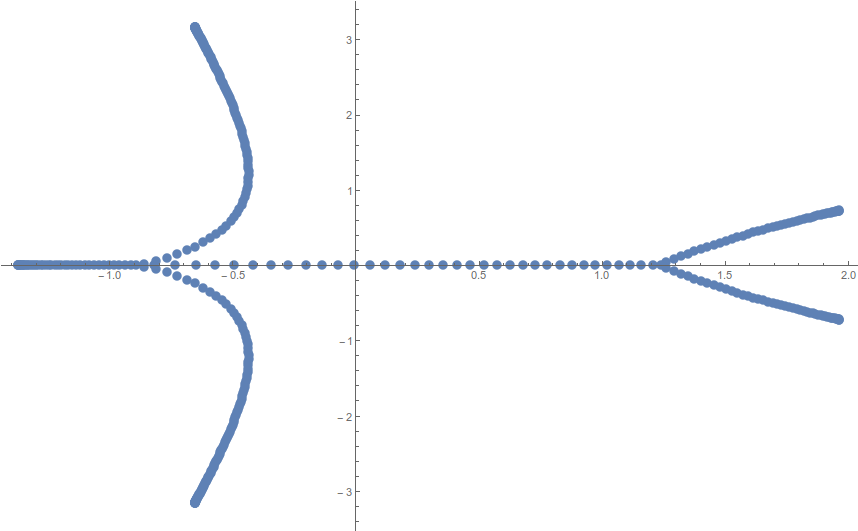Let $T_{n}(b)$ be the $n\times n$ Toeplitz matrix determined by the symbol $$ b(z)=\frac{1}{z}+\sum_{j=0}^{k}a_{j}z^{j} $$ where $k\in\mathbb{N}$ and $a_{0},\dots,a_{k}\in\mathbb{R}$, $a_{k}\neq0$. That means $T_{n}(b)$ is the $n\times n$ left-top truncation of the banded Toeplitz Hessenberg matrix $$ T(b)=\begin{pmatrix} a_{0} & 1 & 0 & 0 & \\ a_{1} & a_{0} & 1 & 0 & \ddots \\ a_{2} & a_{1} & a_{0} & 1 & \ddots \\ a_{3} & a_{2} & a_{1} & a_{0} & 1 & \ddots \\ & \ddots & \ddots & \ddots & \ddots\\ \vdots & & \\ a_{k} \\ & \ddots \\ \end{pmatrix}\!.$$
Further, for $\lambda\in\mathbb{C}$, let $z_{0}(\lambda),\dots,z_{k}(\lambda)$ denote the roots of the equation $b(z)=\lambda$ (repeated according to their multiplicity) arranged such that $$|z_{0}(\lambda)|\leq|z_{1}(\lambda)|\leq\dots|z_{k}(\lambda)|.$$ Schmidt and Spitzer (1960) showed that the set $$\Lambda(b):=\{\lambda\in\mathbb{C} \mid |z_{0}(\lambda)|=|z_{1}(\lambda)|\}$$ coincides with the set of limit points of eigenvalues of matrices $T_{n}(b)$, as $n\to\infty$.
There is a strong numerical evidence (I add 3 pictures approx. $\Lambda(b)$ below) that the set $\mathbb{C}\setminus\Lambda(b)$ is connected though all my attempts to prove this assertion failed. So my question is: $$\textbf{Is the set } \mathbb{C}\setminus\Lambda(b) \textbf{ connected?}$$
Relevant remarks:
If $b$ is a general Laurent polynomial in $z$ (the Schmidt and Spitzer Theorem holds as well), the set $\mathbb{C}\setminus\Lambda(b)$ need not be connected as shown, e.g., in Proposition 5.2. in Böttcher, Grudsky, LAA, 2002. So the particular form of $b$ (or the Hessenberg form of $T(b)$), which we assume, is essential.
If $a_{1}=\dots=a_{k-1}=0$, the set $\mathbb{C}\setminus\Lambda(b)$ is know to be connected.
The set $\Lambda(b)$ is always connected, Ullman, Bull. AMS, 1967.




